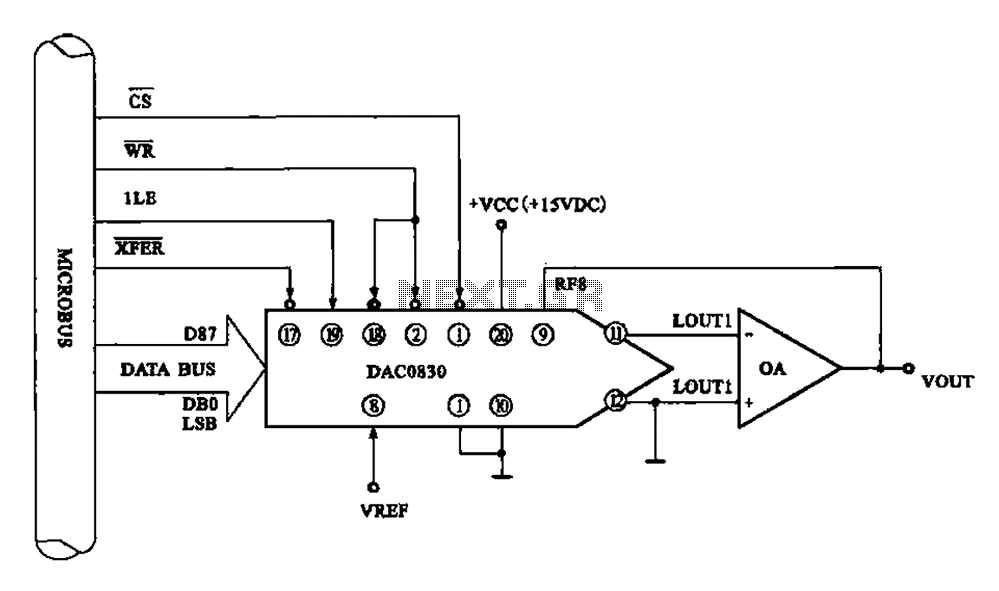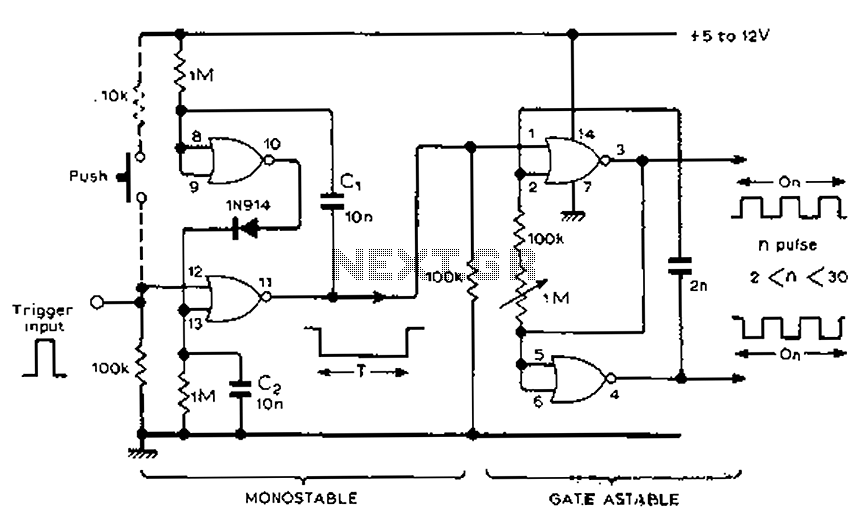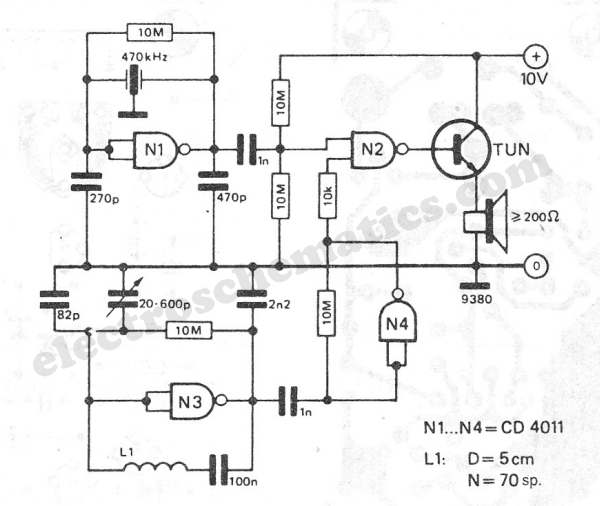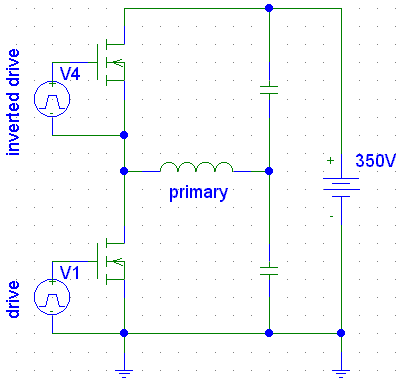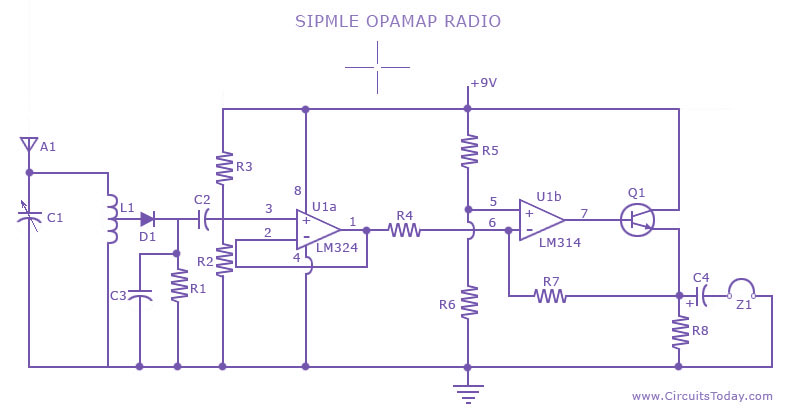
Railway Grade Crossing Circuit
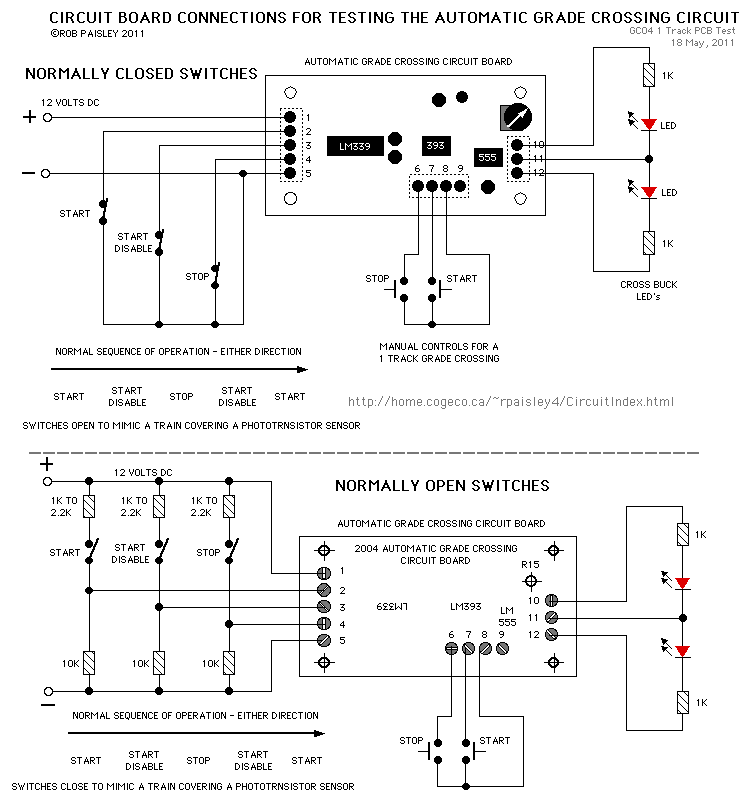
The protected section of track can be of any desired length and does not need to be equal on both sides of the crossing. The circuit operates bidirectionally and can be linked with other grade crossing circuits to provide fully automatic protection for multiple track crossings. The Grade Crossing circuit facilitates realistic operation of signals at level railway crossings and can supply up to 100 milliamps for LED flashers, small incandescent lights, or other devices such as crossing gates or sound units. The circuit board is designed for ease of construction and installation, utilizing widely available and cost-effective components that are not sensitive to static electricity. An upgraded version of the 2004 circuit is available, which is the 2008 Automatic Railway Grade Crossing Circuit, designed to control crossing gates in a prototypical manner. Diagrams illustrate the circuit connections for a single track crossing, including the terminal block positions. Additional diagrams show the placement of phototransistor sensors along the track and the actions taken when each sensor is obstructed by a train. The sensors that activate the flashers can be positioned at any distance from the crossing. The signals will remain activated for approximately two seconds after the last car has completely crossed, uncovering both "STOP" sensors. As the train exits the protected section of track, "DISABLE" sensors prevent the flashers from being reactivated by deactivating the "START" sensors. The circuit is ready for the next train in either direction about five seconds after the "DISABLE" sensors are uncovered. If the departing train continues to obstruct a "START" sensor after this time, the flashers will reactivate. Manual controls are available to start or stop the flashers as needed. The "START" push button can be replaced with a toggle switch to maintain flasher activation during switching operations. Normal room lighting is used to detect trains, but infrared light can be employed for night operations. The Crossing Circuit requires a regulated 12-volt power supply, with a current draw of approximately 3 milliamps when the flashers are off and about 35 milliamps when they are on. Crossing gates and bells can be controlled using the MultiTrack terminal as an output for these devices. The MultiTrack terminal also connects circuit boards for crossings with two or more tracks. Caution is advised, as reversing the polarity of the power supply or connecting to AC or DCC sources will damage the circuit. The maximum supply voltage is 15 volts DC. The printed circuit board for the Automatic Grade Crossing circuit measures two inches by four inches and is commercially manufactured and pre-tinned. The provided price includes six visible/infrared sensitive, 3mm diameter phototransistors, which come with five-inch red and black leads soldered and tested before shipment. When assembling components on the circuit board, it is recommended to start with the lowest profile parts and progress to the tallest, beginning with jumper wires, then diodes, resistors, ICs, transistors, capacitors, and terminal blocks. Diagrams show how two and three circuit boards can be interconnected for multiple track crossings, ensuring full automatic protection for each track. Any number of tracks can be safeguarded using separate circuit boards. It is feasible to use a single circuit board for multiple tracks, but this compromises full automatic control. Two tracks can be protected by one circuit board by placing additional sensors in series with the first track's sensors, providing a cost-saving option. While this setup does not allow for full automatic operation, it can provide prototypical functionality if only one train uses the crossing at a time. The printed circuit board for the 556 Timer Stall-Motor Switch Machine Drivers circuit can be adapted for crossing gate motor drivers. Additional circuits can allow crossing flasher LEDs to be connected with only two wires instead of three, simplifying wiring for small-scale signals. There is an unconfirmed report that the LEDs in the Walters # 933-2914 crossing signals are wired in a common anode configuration, with the black wire as positive and the red wires as negative. The 22-ohm resistors ensure even current distribution through the LEDs, while the 1K-ohm resistors limit current flow and can be adjusted for brightness. A circuit using a 555 timer can cause LEDs to turn on and off more slowly, mimicking incandescent lamps. This setup can also drive higher current light bulbs used in older or larger scale signals. The adapter can connect directly to the Automatic Grade Crossing circuit or through optoisolators if a separate power supply is utilized for the bulbs. To mitigate electrical noise that may trigger the crossing circuit erroneously, small capacitors can be added to the input terminals, slightly delaying activation without affecting overall operation. An updated version of an LM555 timer-based Grade Crossing Bell Ringer circuit was created for the London Model Railroad Group, driving a warning bell shown on the page. Circuit modifications may include lowering the value of R1 and increasing C1 to enhance coil current for a louder ring, requiring some experimentation to find optimal values. Bell modifications involve bypassing the solenoid's circuit-breaking contacts by directly connecting the blue wire to the coil, and adjusting the armature for reduced throw to strike the gong effectively. A similar bell model, 172C, is available at Home Depot in the electrical section, with stock number 106 419.The protected section of track can be as long or as short as desired and does not have to be the same length on both sides of the crossing. The circuit works in both directions and can be connected to other grade crossing circuits to provide fully automatic protection for multiple track crossings.
The Grade Crossing circuit provides prototypical o peration of the signals at level railway crossings and can supply up to 100 milliamps for LED flashers, small incandescent lights or other circuits such as crossing gates or sound units. The circuitboard has been designed to be easy to build and install. Widely available and inexpensive components are used in its construction. None of the parts are static sensitive. An upgraded version of the 2004 circuit is at this link - 2008 - Automatic Railway Grade Crossing Circuit.
The new circuit designed to prototypically control crossing gates. The following diagrams show how the circuit is connected for a crossing with 1 track. A diagram of the circuit board showing the terminal block positions is used. The next diagram shows how the phototransistor sensors are placed along the track and the actions that occur as each is covered by the train. The sensors that start the flashers can be placed any distance from crossing desired. The signals will remain ON until approximately two seconds after the last car has passed completely through the crossing, uncovering both of the "STOP" sensors.
As the train leaves the protected section of track, the "DISABLE" sensors prevent the flashers from being turned ON again by deactivating the "START" sensors. The circuit is ready for the next train in either direction approximately five seconds after the "DISABLE" sensors are uncovered.
If the departing train is still covering a "START" sensor after this time the flashers will turn on again. Manual controls can start or stop the flashers as desired. The START push button could be replaced by a toggle switch in order to keep the flashers activated during switching operations.
Normal room lighting is used to detect the trains. If night operation is needed the circuit can be controlled by other circuits or by providing infrared light for the sensors. The Crossing Circuit requires a regulated 12 volt power supply. The current draw is about 3 milliamps when the flashers are OFF and about 35 milliamps when they are ON.
Crossing gates and bells can be controlled buy using the MultiTrack terminal as an output to control these devices. The MultiTrack terminal is also used to connect the circuitboards together for crossings with two or more tracks.
WARNING - If the polarity of the power supply for this circuit is reversed or the circuit is connected AC or DCC source, the circuit will be damaged. The maximum supply voltage is 15 Volts DC. The following picture is the printed circuit board for the Automatic Grade Crossing circuit. The board is two inches by four inches and has been commercially made and pre-tinned. (An assembled example of the board is also shown. ) NOTE: - The above prices include 6 visible/infrared sensitive, 3mm diameter phototransistors. The phototransisitor have 5 inch - Red and Black leads soldered to them and are tested before shipment.
When installing the components on the circuit board start with parts with the lowest height and work up to the tallest parts. For example starting with the jumper wires then diodes then resistors, IC`s, transistors, capacitors and terminal blocks.
The following diagrams shows how two and three circuitboards are connected for multiple track crossing with full automatic protection for each track. Any number of tracks can be protected using circuitboards for each track at the crossing. The diagrams above show one circuit board for each protected track at a crossing. It is possible to use one circuit board to protect multiple tracks but fully automatic control is not possible when this is done.
Two tracks at a crossing can be protected by a single circuit by placing additional sensors in series with the sensors of the first track. This is a cost saving measure. Because only one circuitboard is used, fully automatic operation is not possible as with the two circuitboard - two track crossing but if only one train uses the crossing at a time, the system will give prototypical operation.
Because only one circuit is used, fully automatic operation is not possible as in the full two track crossing but if only one train uses the crossing at a time, the system will give prototypical operation. The printed circuit board for the 556 Timer Stall-Motor Switch Machine Drivers circuit could be used to make Crossing Gate motor drivers.
See the "Additional Circuits" section of the page. The circuit in the following link will allow the crossing flasher LEDs to be connected using only two wires instead of three as in the circuits above. This could make wiring of small scale signals easier. Unconfirmed - The LEDs in the Walters # 933-2914 crossing signals are wired in a common anode circuit but the Black wire is the positive and the Red wires are the negative.
The 22 ohm resistors distribute the current evenly though the LEDs. The 1K ohm resistors limit the current flow through the LEDs and can be changed if the brightness of the LEDs needs to be adjusted. This circuit when used with a 555 timer will cause light emitting diodes to turn on and off more slowly.
This will make the LEDs appear similar to incandescent lamps. This circuit can be used to drive higher current light bulbs that are found in older or large scale signals. The adapter can be connected directly to the Automatic Grade Crossing circuit or through optoisolators if a separate power supply is to be used for the bulbs.
If there is electrical noise that causes the crossing circuit to trigger falsely, small capacitors can be added to the input terminals. This will make the crossing circuit slightly slower to activate but will not affect the operation of the circuit.
This is an updated version an LM555 timer based - Grade Crossing Bell Ringer - circuit that was built for the London Model Railroad Group. The circuit drives a warning bell that is shown on the page. CIRCUIT MODIFICATIONS - The value of R1 may be lowered and the value C1 increased to give a more powerful coil current for a louder ring.
Some experimentation may be needed to determine the best values for a particular situation. BELL MODIFICATIONS - The circuit-breaking contacts of the bell`s solenoid are not used and have been bypassed by connecting the blue wire directly to the coil. The armature has been bent so that less throw is needed for it to strike the gong. Home Depot carries a bell in their electical section that is similar to the one shown on this page. The model number is 172C and the stock number is 106 419 🔗 External reference
The Grade Crossing circuit provides prototypical o peration of the signals at level railway crossings and can supply up to 100 milliamps for LED flashers, small incandescent lights or other circuits such as crossing gates or sound units. The circuitboard has been designed to be easy to build and install. Widely available and inexpensive components are used in its construction. None of the parts are static sensitive. An upgraded version of the 2004 circuit is at this link - 2008 - Automatic Railway Grade Crossing Circuit.
The new circuit designed to prototypically control crossing gates. The following diagrams show how the circuit is connected for a crossing with 1 track. A diagram of the circuit board showing the terminal block positions is used. The next diagram shows how the phototransistor sensors are placed along the track and the actions that occur as each is covered by the train. The sensors that start the flashers can be placed any distance from crossing desired. The signals will remain ON until approximately two seconds after the last car has passed completely through the crossing, uncovering both of the "STOP" sensors.
As the train leaves the protected section of track, the "DISABLE" sensors prevent the flashers from being turned ON again by deactivating the "START" sensors. The circuit is ready for the next train in either direction approximately five seconds after the "DISABLE" sensors are uncovered.
If the departing train is still covering a "START" sensor after this time the flashers will turn on again. Manual controls can start or stop the flashers as desired. The START push button could be replaced by a toggle switch in order to keep the flashers activated during switching operations.
Normal room lighting is used to detect the trains. If night operation is needed the circuit can be controlled by other circuits or by providing infrared light for the sensors. The Crossing Circuit requires a regulated 12 volt power supply. The current draw is about 3 milliamps when the flashers are OFF and about 35 milliamps when they are ON.
Crossing gates and bells can be controlled buy using the MultiTrack terminal as an output to control these devices. The MultiTrack terminal is also used to connect the circuitboards together for crossings with two or more tracks.
WARNING - If the polarity of the power supply for this circuit is reversed or the circuit is connected AC or DCC source, the circuit will be damaged. The maximum supply voltage is 15 Volts DC. The following picture is the printed circuit board for the Automatic Grade Crossing circuit. The board is two inches by four inches and has been commercially made and pre-tinned. (An assembled example of the board is also shown. ) NOTE: - The above prices include 6 visible/infrared sensitive, 3mm diameter phototransistors. The phototransisitor have 5 inch - Red and Black leads soldered to them and are tested before shipment.
When installing the components on the circuit board start with parts with the lowest height and work up to the tallest parts. For example starting with the jumper wires then diodes then resistors, IC`s, transistors, capacitors and terminal blocks.
The following diagrams shows how two and three circuitboards are connected for multiple track crossing with full automatic protection for each track. Any number of tracks can be protected using circuitboards for each track at the crossing. The diagrams above show one circuit board for each protected track at a crossing. It is possible to use one circuit board to protect multiple tracks but fully automatic control is not possible when this is done.
Two tracks at a crossing can be protected by a single circuit by placing additional sensors in series with the sensors of the first track. This is a cost saving measure. Because only one circuitboard is used, fully automatic operation is not possible as with the two circuitboard - two track crossing but if only one train uses the crossing at a time, the system will give prototypical operation.
Because only one circuit is used, fully automatic operation is not possible as in the full two track crossing but if only one train uses the crossing at a time, the system will give prototypical operation. The printed circuit board for the 556 Timer Stall-Motor Switch Machine Drivers circuit could be used to make Crossing Gate motor drivers.
See the "Additional Circuits" section of the page. The circuit in the following link will allow the crossing flasher LEDs to be connected using only two wires instead of three as in the circuits above. This could make wiring of small scale signals easier. Unconfirmed - The LEDs in the Walters # 933-2914 crossing signals are wired in a common anode circuit but the Black wire is the positive and the Red wires are the negative.
The 22 ohm resistors distribute the current evenly though the LEDs. The 1K ohm resistors limit the current flow through the LEDs and can be changed if the brightness of the LEDs needs to be adjusted. This circuit when used with a 555 timer will cause light emitting diodes to turn on and off more slowly.
This will make the LEDs appear similar to incandescent lamps. This circuit can be used to drive higher current light bulbs that are found in older or large scale signals. The adapter can be connected directly to the Automatic Grade Crossing circuit or through optoisolators if a separate power supply is to be used for the bulbs.
If there is electrical noise that causes the crossing circuit to trigger falsely, small capacitors can be added to the input terminals. This will make the crossing circuit slightly slower to activate but will not affect the operation of the circuit.
This is an updated version an LM555 timer based - Grade Crossing Bell Ringer - circuit that was built for the London Model Railroad Group. The circuit drives a warning bell that is shown on the page. CIRCUIT MODIFICATIONS - The value of R1 may be lowered and the value C1 increased to give a more powerful coil current for a louder ring.
Some experimentation may be needed to determine the best values for a particular situation. BELL MODIFICATIONS - The circuit-breaking contacts of the bell`s solenoid are not used and have been bypassed by connecting the blue wire directly to the coil. The armature has been bent so that less throw is needed for it to strike the gong. Home Depot carries a bell in their electical section that is similar to the one shown on this page. The model number is 172C and the stock number is 106 419 🔗 External reference
Warning: include(partials/cookie-banner.php): Failed to open stream: Permission denied in /var/www/html/nextgr/view-circuit.php on line 713
Warning: include(): Failed opening 'partials/cookie-banner.php' for inclusion (include_path='.:/usr/share/php') in /var/www/html/nextgr/view-circuit.php on line 713
